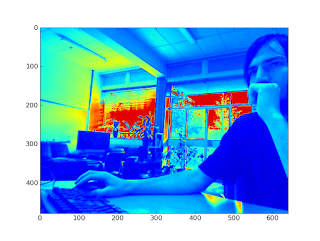I have been looking at harris feature detection lately. Implementing it side by side in OpenCV and SciPy, luckily for me a SciPy implementation by Jan Solem was found on this blog. As I was going through the code, I wanted to get my head around what was happening. So using these two lines:
from IPython.Shell import IPShellEmbedIPShellEmbed()()
This piece of magic can be put anywhere, right deep inside a nested loop, inside a function called from X via Y via Z etc. And it obviously pops you right into the brilliant IPython shell, with the full normal IPython luxuries like timeit, history, autocomplete, pylab plotting... So I plotted a few images midway through processing, just to see what the program sees.

First is the grayscale image taken from my webcam. No I'm not colour blind - I realize I have plotted it in colour.... Second and thirdly the two gaussian derivatives of the image, one in X and one in Y.

Oh and check it out - my first conference presentation!
Ahh, I'm going to have to prepare something now!

